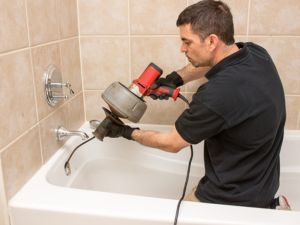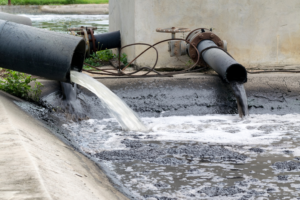Drain Cleaning Aurora, CO is an essential preventative maintenance service that eliminates odor-causing bacteria, fungus, and mold. It can also reduce the risk of costly pipe repairs and replacements.
Whether in commercial kitchens or multifamily dwellings, food particles can bind with soap scum and hair to create stubborn drain blockages. Regularly using the following DIY methods can keep your drains clean and unclogged.

Baking soda and vinegar are natural ingredients that can help unclog drains. This method is a quick, inexpensive, and effective way to remove buildup from kitchen sinks and disposals, as well as bathtub and shower drains. It also helps eliminate odors and keep drains smelling fresh. This simple mixture is a nontoxic alternative to chemical drain cleaners, which can damage pipes and the environment.
To use this drain cleaning technique, first remove the drain cover or filter and clean out any visible debris that may be present. Pour a cup of baking soda into the drain and allow it to sit for about three to five minutes. Then, pour a cup of white vinegar into the drain and let it react with the baking soda. The chemical reaction should produce a lot of bubbles, which can dislodge any food particles or grease that have accumulated in your drain. Once the bubbling has stopped, flush out the drain with hot water. Repeat this process as needed to maintain a clear and functional drain.
When combined, the acid in the vinegar and the alkaline in the baking soda creates a powerful natural drain cleaner that can dissolve many types of blockages. This mixture is especially effective for grease clogs and other types of organic clogs, as it destroys fats, oils and proteins that can build up and obstruct drains. Vinegar is also a safe and nontoxic alternative to store-bought drain cleaners, which often contain sodium hydroxide, a dangerous chemical that can corrode your pipes over time.
While this drain cleaner can eliminate many small clogs, it is not a good choice for larger ones or stubborn blockages. If you encounter a blocked drain that doesn’t respond to this remedy, it is best to use a drain snake or remove your drain trap to manually dislodge the blockage with a plunger or other tool.
If you are concerned about damaging your pipes, it’s best to consult a professional plumber before using any homemade or DIY drain cleaning products. They have specialized tools and knowledge that can prevent further damage to your plumbing system and make it easier to resolve the clog.
Boiling Water
Pouring boiling water down a drain is a common home hack that has some power to dissolve certain types of clogs. The concept is straightforward: a large amount of thermal energy can quickly break down organic materials that lead to blockages, particularly when they are melted in a liquid state. Additionally, thermal expansion can force shifts within the material structure of pipes and help dislodge obstructions.
Unfortunately, pouring boiling water down a drain is not always effective and can be dangerous depending on the type of pipe you have in your home and the nature of your clog. For example, PVC pipes can soften and weaken under high temperatures, making them more susceptible to warping and damage. Additionally, if your clog is caused by solid objects like toys or sanitary products, boiling water will likely not be effective and may even push them deeper into the pipes.
When combined with dish soap, however, boiling water can be an effective solution for greasy or soapy clogs. Start by squirting some mild dish soap directly down the drain, then follow up with several cups of boiling water. The heat from the boiling water will help to melt any grease that has accumulated, while the dish soap will help emulsify it so that it can be flushed away more easily.
Adding salt to the mixture can also make the process more effective, as the natural abrasiveness of the substance will help scour away any remaining residues and debris. For best results, add salt in 1/2-cup increments and flush the drain with hot water after each addition.
Another surprisingly effective home-based solution for greasy or soapy clogs is cola, which contains an acidic ingredient that has the ability to dissolve and dislodge some of the most stubborn clogs. Simply pour a can of name-brand cola down the drain, wait a few hours for the corrosive ingredients to work their magic, then rinse out the drain with some hot water and your clog should be history.
Dish Soap
One of the most versatile cleaning products in your home is liquid dish soap. It can remove stubborn grease and oil buildup, help fade stains on clothing and fabrics and is safe to use on many surfaces. It can also be used as an emergency drain cleaner when a clog occurs.
Before using this option, make sure you remove any visible debris in the drain and if possible, open the sink and faucet to clear away the remaining clog material. Once the drain is free, you can rinse it with hot water. If the clog is still there, repeat the process. Alternatively, you can mix a solution of equal parts baking soda and salt and pour the mixture into the problematic drain. Leave it alone for an hour and then rinse with hot water. This method is a little more complicated than just pouring a single solution down the drain but it works well in most cases.
You can purchase liquid dish soap in both conventional and eco-friendly versions. The Good Housekeeping Institute Cleaning Lab has tested numerous brands and found that the best ones contain effective cleaning agents, are gentle on hands and safe for various materials and surfaces. Look for a mild fragrance and low SLS (sodium laurel sulfate) content. Additionally, look for a nontoxic formula and ingredients that are grey-water, septic and sewer safe.
A clogged drain is no fun, and it can be even more frustrating when you don’t have any available remedies. However, you can prevent clogs in the future by practicing good habits, such as only putting food, fats and oils down your drains, and by regularly using a natural drain cleaner to keep your pipes clean.
Most commercial drain cleaners contain harsh chemicals such as sulfuric acid, hydrochloric acid (muriatic acid) and sodium or potassium hydroxide (lye). These can cause damage to your pipes and are dangerous if you don’t follow the instructions on the bottle closely. In addition, the drain cleaners can corrode your pipes and may not work as well on stubborn clogs.
Chemical Cleaners
Chemical cleaners are specialized solutions that clean, degrease, and sanitize surfaces. They come in a variety of forms, such as soaps, detergents, disinfectants, solvents, and abrasives. The chemical composition and physical properties of a cleaning solution determine its effectiveness for a specific task. Cleaning chemicals can be found for many surfaces and applications, including concrete, water treatment, sewage and industrial waste, automobiles, and food processing equipment.
A chemical cleaner works by penetrating surface soils, absorbing them into the cleaning solution, and then washing them away with the solution. In some cases, this is done by wiping or mopping the surface, while in others, it involves scrubbing and rinsing. These chemicals can be mild or aggressive, depending on their formulation and the type of surface being cleaned.
Corrosive cleaners are extreme on the pH scale, either alkaline or acidic. They corrode organic and inorganic contaminants, eating them away by chemical reaction. They also tend to be quite caustic, burning the skin and causing chemical burns in the lungs when inhaled.
Most corrosive cleaners are highly concentrated and expensive, but they are effective at removing very stubborn foulants such as heavy oils or biological material. Many cleaning products contain both surfactants and chelating agents to make them more effective. A surfactant is a chemical that, when dissolved in another liquid such as water or an acid, attaches to the surfaces of solid particles and binds them together. These agents also surround unwanted metal ions and tie them up so that they cannot precipitate out of the solution.
The most common corrosive cleaning agent is sulfuric acid, commonly used in drain cleaners and oven cleaners. This can eat through almost anything and is very dangerous to use unless you are an experienced professional using a respirator. Some less toxic but still very caustic chemicals include sodium carbonate and washing soda, which can corrode aluminum products and attack grease and protein deposits. These are very irritating to the skin and can burn the lungs if inhaled, so it is important to wear gloves and safety goggles when working with these chemicals.
